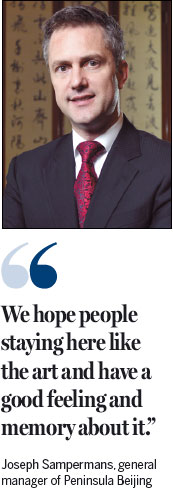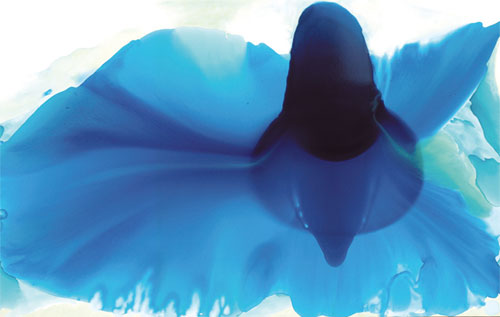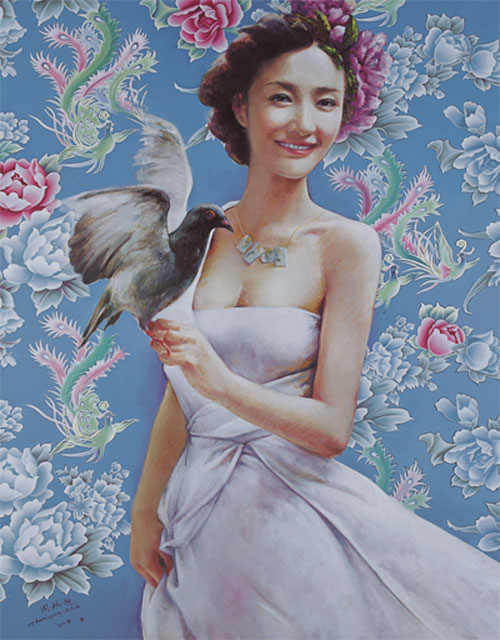Hotel puts art at core of program
Residencies allow guests to interact with artist and their works, Fu Chao reports.
Most upscale hotels today have artworks displayed in their public spaces, as a brand highlight or just part of the decor. The Peninsula Beijing also offers visitors art displays, but the hotel does more than that.
In September 2013, the hotel started an innovative Art Residency program, which invites Chinese artists chosen to represent the country's most creative contemporary art scene to stay in the hotel for three months and create artworks. The subsequent work is displayed in the hotel where guests can interact with the artist during their stay.
The hotel even remodeled one of its largest suites into an Art Suite where the artists can live and also use it as a studio.
Joseph Sampermans, the general manager of Peninsula Beijing and a keen art lover himself, said the program began because he was so impressed by the wide scope and amount of art in China.
Sampermans took the position of general manager in the hotel two years ago. A Dutch national, he has a personal as well as professional interest in China and reads a lot about the country. Slim, tall, with bright eyes and a warm smile, Sampermans can speak with endless passion about art, the program and the topic of hotel service.
Guest interaction
After coming up with the initial idea for the program, Sampermans said they want to make it more sustainable as not many hotels have permanent display of artworks.
In the past year or so, every three months there has been a new artist-in-residence bringing his or her own spark of creativity to the hotel.
In cooperation with the Museum of Art and Urbanity Shanghai, known as MAUS, the hotel has thus far presented the work of six artists.
Sampermans said the hotel has its own ideas and principles for artist selection.
"The artist should have been producing art for a number of years. They should have already devoted quite a bit of their time and life to their art."
After nailing down the form and the artists, Sampermans has sought to make the program interesting and unique for both the artist and hotel guests.
"What we thought would be best is the artist is here. Then people can talk to the artist, he can show them the piece of art and explain to them why he created it, what was the emotional setting. That is what I think makes the art experience different."
Sampermans hopes that the program will not only offer leading Chinese artists an opportunity to present their work and ideas, but also offer accessibility for art lovers to connect with the artists.
Oscar Prat van Thiel, cofounder and operations director of MAUS and the China Europe Art Operation Center, who spoke highly of the program as a "pioneer", said that by being located in downtown Beijing in a space that is not normally associated with art, the hotel brings artists and their work closer to members of the public that may not normally go to museums or galleries.
Sampermans noted, more than once, that the program is not for commercial profit.
"The idea is really to have art on display, to have somebody who loves to create art staying with us and sharing with us his or her passion."
The current artist-in-residence is Wu Yaming, a well-known Chinese contemporary landscape painter. Wu has spent 45 years painting and his works, which are mostly ink wash paintings tinged with the ethos of Buddhist culture, Zen and an unconventional freedom, are highly regarded both in China and abroad.
The exhibition is about "Being", van Thiel said. "People nowadays seem very busy having and doing, forgetting however, that prior perhaps to this and central to life is simply to be."
He said Wu was chosen not only for his undoubted technical mastery but also because of the vitality and youth transmitted through his works.
"The daring use of color in traditional Chinese settings and the virtuosity of his compositions make Wu Yaming one of the rarer traditionalstyle artists that may be immediately 'understood' by foreign audiences, making him a special cultural ambassador," he said.
One of Wu's massive paintings, The Spring Time Fills the Valley, is displayed in the middle of the lobby. It is a traditional Chinese ink wash, but the color combination is modern and bold. Sampermans said he was also amazed by its colorfulness.
"And don't touch it," he said, half in jest, but still resembling a cautious security guard in a gallery.
Art as brand culture
Although the Art Residency is not specifically designed to attract more guests, to some extent it does create guest loyalty, Sampermans said.
Part of the Peninsula brand culture has always been a conscious effort to incorporate artisanship into its hotels.
In the Peninsula Beijing, Sampermans wants the art program and all the artworks to add to the guests' personal connection to the hotel.
Besides, he said, in the end what matters the most in good hotel service always comes down to people - the staff.
Sampermans said the hotel is sending staff to different countries to learn from the brand's other properties.
The hotel is also developing an app for the art program. Named Art Walk, the app will be available on iPads that will be provided to hotel guests and will show the location of each artwork, guiding guests on an art journey through hotel. Guests can also scan a QR code on each work to get detailed information.
The hotel is undergoing renovation soon to create a better hotel experience and to provide better facilities for art exhibitions.
"We hope people staying here like the art and have a good feeling and memory about it," Sampermans said, expressing his simple and genuine wish.
Contact the writer at fuchao@chinadaily.com.cn



|
Creations by artists-in-residence at the hotel recruited for the program. Provided to China Daily |
(China Daily 02/07/2015 page10)













